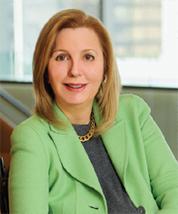Nancy Lieberman '79: Grit and Determination are Lawyer’s Keys to Remarkable Career

Nancy Lieberman, ’79, went off to college when she was 16. She started at the Law School when she was 19. At 22, she was clerking for a US Court of Appeals judge. When she was 30, after less than six years as an associate, she became the youngest partner in the history of Skadden Arps Slate Meagher & Flom LLP. Not long after that, she was named as one of the 50 most influential women lawyers in America. “I’m not brilliant,” she says. “I’m goal-driven and tough. I have a lot of grit.” Many would disagree with the first part of her self-characterization, but her life has demonstrated that there is no doubt about her toughness and her grit.
She says that one thing she loves about the Law School is that it demands, and builds, those same qualities of grit and determination. She recalls the storm-of-the-century blizzard that hit Chicago during her third year: “Everything was shut down. No one could get around. There were mountains of snow and then temperatures fell below zero, so everything was covered with ice. But the Law School was open and we were expected to somehow get ourselves to class on time. And we did.”
“It was the same at the academic level,” she says. “The Law School was hard and intense. But you dealt with it. And when you did, your determination was rewarded. After Chicago, everything else was a cakewalk.”
Her work at Skadden Arps has focused on mergers and acquisitions. She recalls the challenges and the exhilaration of her early days in that field: “There was hardly any legal structure for M&A work then. We were making it up as we went along. One day Carl Ichan would be going after a client of ours and we’d be figuring out what to do. Another day one of the great geniuses, a Joe Perella or a Bruce Wasserstein, would want to do some far-out thing and we’d figure that out, too. We always were working at the outer edges of what was possible.”
Into the 1990s and beyond, honors and client assignments flowed in for her. When she was 40 she got married, to Mark Ellman. They have a son, Eric, who is now a teenager.
On the day before Christmas in 2007, she was skiing when she lost control and headed into a grove of trees. She hit one of them, and it broke her neck, rendering her quadriplegic. Through surgeries, stretches in hospitals, and more than a year of dogged recuperation, she regained the use of her arms and limited use of her hands. A new, experimental treatment aided her recovery, and she has been a determined fundraiser in support of further advances for treating spinal cord injuries.
She returned to work, at first in an administrative role, in the wheelchair that she still requires today and with only a very constricted ability to do many of the tasks, such as word processing, that most lawyers take for granted. Soon she was taking on the same kinds of assignments that she had been handling before the accident and doing them at the same high level. Last year, for client work that included extricating a biotech company from its contract with a big pharma giant and then helping to sell it to a different giant in a seven-billion-dollar deal, she was named by Law 360 as one of a handful of the world’s “M&A MVPs.”
“Skadden has been fantastically supportive in every way throughout my career, through all of the ups and downs,” she says. “In my view, it’s the most progressive law firm ever.”
Among those who visited her during her recuperative year were Geof Stone and Richard Epstein. She credits Stone with having turned around her law school career when she went to his office to confess that she was understanding virtually nothing in the evidence class he was teaching. “He sat with me for three hours, patiently taking me through the materials, until suddenly it all clicked. Not just evidence, but really what the study and practice of law were about and how to succeed at them. I owe my career to him, and to the many other faculty members who then were able to fill my head with what they knew. Richard Epstein, Bernie Meltzer, Phil Neal—you name them and I’m grateful to them. I’m just an average American who knows a lot of things and works really hard, but those faculty members who taught me how to think differently—they were brilliant.”